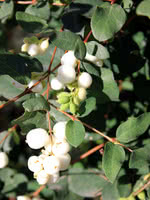Mon-Fri 9am - 5pm Mountain time
Common Snowberry vs Red Alder
Symphoricarpos albus
Alnus rubra
CUSTOM GROW
Common Snowberry is a small deciduous shrub with characteristic white to pink flowers and clusters of white fruit.
This North American native species is very adaptable, and can be used for erosion control in riparian and restoration areas. Snowberry's fruit attracts wildlife, and livestock can consume the berries without issue.
Red Alder is a fast-growing deciduous tree native to western North America. Through its nitrogen-fixing roots and nitrogen-rich leaf litter, Red Alder improves soil fertility and supports the growth of surrounding plants. This makes it especially valuable on disturbed sites following logging, construction, or fire. A classic pioneer species, it often colonizes bare ground and enhances conditions for longer-lived conifers to follow.
Red Alder stabilizes soils on streambanks and disturbed slopes, reducing erosion and aiding restoration. It also supports wildlife: birds and small mammals eat the seeds and buds, deer and elk browse the foliage, and bees are drawn to the pollen-rich catkins in spring.
Red Alder also has commercial importance, with its strong yet workable wood widely used for furniture, cabinetry, veneer, and pulp. The tree takes its name from the rusty-red color the bark turns when cut or bruised.
Common Snowberry Quick Facts
Red Alder Quick Facts
Toxicity: berries toxic to humans

